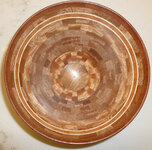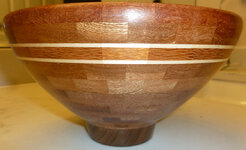NGLJ
Member
I haven't made a segmented bowl in a while since I have been busy learning as much as I can about pen turning. However, I do remember someone saying "don't forsake your other woodworking now that you are turning pens". This was good advice and I took it to heart. The attached is mainly sapele with a walnut base, a feature ring consisting of lacewood sandwiched between hard maple, and a mahogany rim. I experienced one of the challenges with sapele in that it chips easily where the grain is somewhat figured. So you must take lite cuts or you will end up getting an ever shrinking wall thickness, which can lead to disaster.
I did turn another bowl prior to this but don't have any photos because I gave it away to the woodworker who gave me the material. He gave me some bamboo flooring planks, which I have never turned before. The planks are made by taking bamboo strips (42 lb/cu ft) and applying heat and pressure (71 lb/cu ft). That stuff is sure hard, which is you want for flooring, and easily chips when turning. My first attempt went from a bowl to small platter (the lower part of the bowl). The rest took off across the workshop . I discovered that you had better finalize the shape before any sanding because the heat from sanding seems to create a surface reaction which makes the surface so hard it is like turning concrete! I have some boards left and might try and make another one. If you get the turning right it finishes very nicely.
. I discovered that you had better finalize the shape before any sanding because the heat from sanding seems to create a surface reaction which makes the surface so hard it is like turning concrete! I have some boards left and might try and make another one. If you get the turning right it finishes very nicely.
I did turn another bowl prior to this but don't have any photos because I gave it away to the woodworker who gave me the material. He gave me some bamboo flooring planks, which I have never turned before. The planks are made by taking bamboo strips (42 lb/cu ft) and applying heat and pressure (71 lb/cu ft). That stuff is sure hard, which is you want for flooring, and easily chips when turning. My first attempt went from a bowl to small platter (the lower part of the bowl). The rest took off across the workshop


